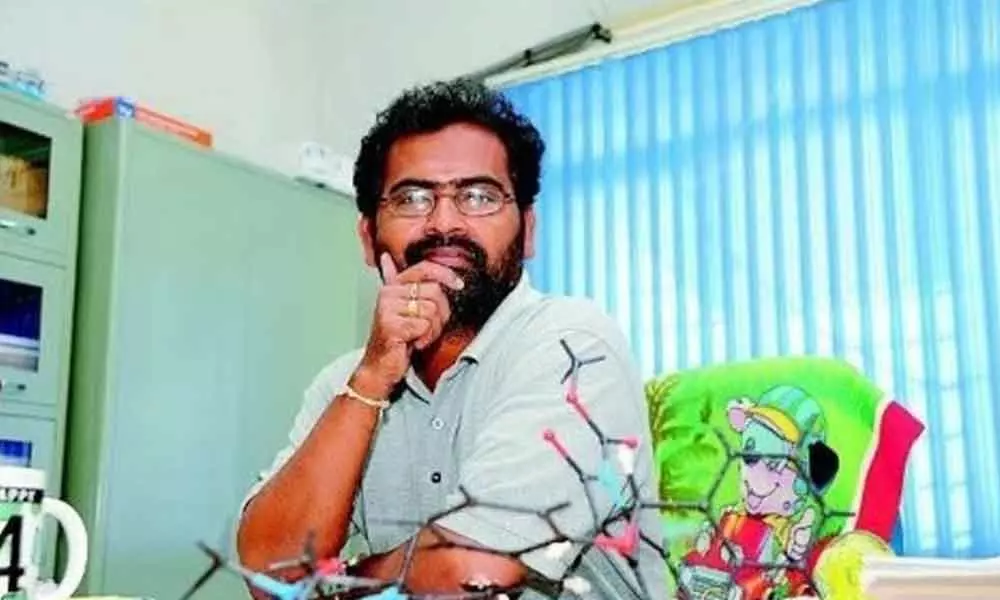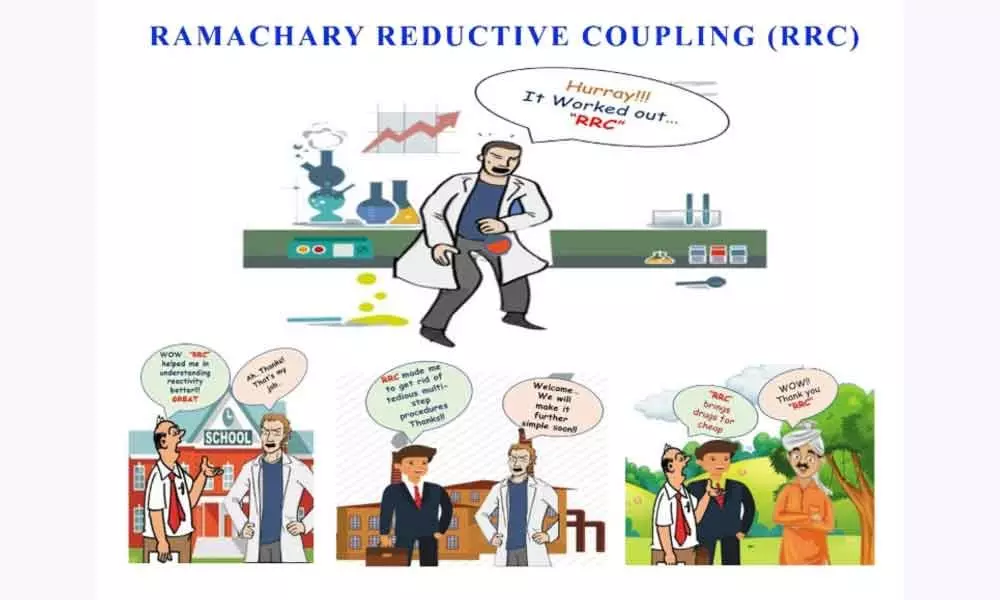Breakthrough findings by University of Hyderabad professor
Prof D B Ramachary’s laboratory at School of Chemistry, University of Hyderabad (UoH) has made some seminal contributions in developing new, novel, and green reactions of both achiral and chiral version of organocatalytic reductive coupling reaction, dienamine-catalysis, aminoenyne-catalysis, base induced ring opening (BIRO) reaction, asymmetric supramolecular-organocatalysis, an enamine- and enolate-mediated organocatalytic azide–carbonyl [3+2]-cycloaddition reactions through bio-mimetic organocatalysis.
Hyderabad: Prof D B Ramachary's laboratory at School of Chemistry, University of Hyderabad (UoH) has made some seminal contributions in developing new, novel, and green reactions of both achiral and chiral version of organocatalytic reductive coupling reaction, dienamine-catalysis, aminoenyne-catalysis, base induced ring opening (BIRO) reaction, asymmetric supramolecular-organocatalysis, an enamine- and enolate-mediated organocatalytic azide–carbonyl [3+2]-cycloaddition reactions through bio-mimetic organocatalysis.
These findings have received wide attention of researchers world-wide; it is expected that they will pave way to utilise for the design and synthesis of new drugs, materials and natural products in more economical manner and also will give inspiration for the development of new reactions with enhanced selectivity and reactivity.
What is a named reaction?:
A name reaction is a chemical reaction named after its discoverers or developers. Among the tens of thousands of organic reactions that are known, hundreds of such reactions are well-known enough to be named after discoverers or developers. The well-known chemical reactions include the Grignard reaction, the Wittig reaction, the Claisen condensation, the Friedel-Crafts acylation, the Barton reaction, the Diels-Alder reaction, the Sharpless epoxidation, the Noyori hydrogenation, the Grubbs olefin metathesis, and the Suzuki coupling. Reviews and books have been published devoted exclusively to the name reactions, and many Indexes are developed based on the named reactions.
As organic chemistry developed during the 20th century, chemists started associating synthetically and medicinally useful reactions with the names of the discoverers or developers; in many cases, the name is merely a mnemonic. Many chemists from different nations contributed to this privileged list of name reactions. In 1934 our Indian chemist, Prof. K. Venkataraman also contributed through his reaction and that was named after him along with Prof. Dr. Wilson Baker as "Baker–Venkataraman rearrangement".
As a result of the last two decades of work, a few originally developed reactions in Ramachary's laboratory from School of Chemistry, UoH become highly useful for organic to medicinal to material chemists and become well-known organic reactions to be named after him. We have listed the information on those reactions below.
Ramachary Reductive
Coupling Reaction:
Ramachary's group has developed a new metal-free coupling reaction called "Three-Component Reductive Alkylation (TCRA) reaction" in which different active methylenes undergo a coupling reaction with a library of aldehydes/ketones and Hantzsch ester under amino acid-catalysis to produce green coupled alkylation products, which are shown to be drug intermediates and ingredients. The organocatalytic reductive coupling reaction become very good tool for synthetic chemists to make metal-free C-C bond coupling between highly reactive CH-acids and aldehydes/ketones.
Ramachary-Bressy-Wang
Cycloaddition:
Ramachary's group has developed for the first time a new reactive species called "push-pull dienamines (PPD's)" from the reaction of amines with functionalized cyclohexenones at room temperature and has demonstrated many applications of push-pull dienamine chemistry through fine chemical synthesis. First time, Ramachary's group has developed the copper-free click reaction between cyclohexenones and azides to make functionally rich 1,2,3-triazoles from push-pull dienamine-catalysis, which is now become novel reaction for many applications and giving inspiration to develop many new reactions. Recently many chemists recognized and started calling this metal-free click reaction as "Ramachary-Bressy-Wang Cycloaddition".
Ramachary 2-Aminobuta-1,3-enyne-catalysis:
The asymmetric synthesis of drug-like spirocyclic cyclohexanes having five to six contiguous stereocenters has been developed through reflexive-Michael reaction by using novel 2-amino but-1,3-enyne-catalysis followed by reduction/oxidation reactions from simple precursors under the mild conditions. First-time Ramachary's group has shown the in situ generations and application of 2-amino but-1,3-enynes in asymmetric reactions. Some of these molecules are looking at better anti-cancer agents.
Ramachary Base Induced Ring Opening (BIRO) Reaction:
A few years back, Ramachary's group has developed a new reaction called "base induced ring-opening (BIRO)" reaction to furnish the functionalized Z-dienes from simple heterocycles.
Asymmetric Supramolecular-Organocatalysis:
Recently, Ramachary's group initiated the demonstration of cellular-type reactions in the vial by combining multi-catalysis strategies and multi-components in one-pot to deliver highly functionalized optically pure molecules with good yields and selectivity through the formation of supramolecular assembly at the pre-transition state level. This approach created new catalysis called "asymmetric supramolecular-organocatalysis" and demonstrated the first time how important for the synthesis of chiral molecules with high selectivity and also to study the pre-transition state. This technology may give directions to develop a complete greener asymmetric chemistry in the near future.
Ramachary Organocatalytic Azide–Carbonyl [3+2]
-Cycloaddition:
Ramachary's group has developed for the first time an enolate-mediated organocatalytic azide–carbonyl [3+2]-cycloaddition to furnish the various functionally rich drug-like 1,2,3-traizoles at room temperature. This is first time to develop the copper- and alkyne-free click reaction from enolate-catalysis, which is now become novel reaction for many applications.
















